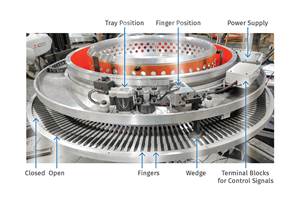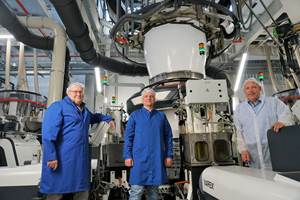For W&H, Big Themes are MDO, the Circular Economy, Retrofits
NPE2024: Machine builders responding to a need for flexible packaging processors are looking to make their operations more sustainable.
Flexible packaging processors are looking to make their operations more sustainable, whether by internal mandate or brand owner demand. The challenge they face is to produce products that, while greener, still perform as well as the structures they are replacing. At NPE2024, Windmoeller & Hoelscher (W&H) will be offering a number of solutions to help them down that path.
Machine-direction orientation (MDO) of films is one technology the machine builder believes will not only help processors simplify the design of their products — generally going with an all-PE coextrusion at the expense of polyesters — for pouch-making and other films but perform the way the more complicated, multimaterial structures did.
“Worldwide we’ve sold about 170 MDO systems into the market — with 30 in North America — and in the first few years they were almost exclusively for breathable (back sheet) films, such as diaper backing materials,” notes Andrew Wheeler, W&H’s North American president. “But over the last 3-4 years, the installations have been growing for PET replacement. So yes, this does fall under the category of ‘circular economy.’ But, just as importantly, our MDO customers are getting the same barrier and stiffness properties that are needed for applications like pouch-making.”
Of course, another path to the circular economy is running both postindustrial and postconsumer content, and Wheeler reports that “many of our customers are working with PCR and we have found that our equipment runs it really well.” Over the years, Wheeler notes that a handful of stretch film processors have set up recovery efforts so they can repurpose old stretch film into new. PCR, however, can be a little more problematic to reprocess, depending on the source, he notes.
Says Wheeler, “If you are sourcing material from the best-of-the-best recycler out there and getting great pellets, you are still going to see a 30% variation in melt index and density. It can be extremely challenging, because when you have materials with different melt indexes and densities, you’ll wind up with gels and unmelt, and all the other unpleasant things associated with PCR. Certainly, you need to have additional filtration.”
Wheeler notes that one way to “keep the dirt out” is to run PCR in discrete layers, usually the core. But longer term, processors are facing demands by some brand owners for film structures containing up to 70% PCR. “If PCR is causing any imperfections in the melt, those imperfections are going to be made worse in the film production process,” Wheeler says.
Another challenge film processors are coming up against is the growing requirement to run structures free of per- and polyfluoroalkyl substances (PFAS) per- and polyfluoroalkyl substances (PFAS). Says Wheeler, “Many film producers are committed to running PFAS-free, but it’s like making scrambled eggs with no oil or butter. With PFAs-free materials, the outputs are typically below what they were, and there is generally more die buildup requiring more frequent cleanings. Processors look to the machinery suppliers for help. Ultimately, I’m confident the resin and process aid suppliers will develop a long-term solution, and we’ll be working with them along the way.”
Known primarily as a supplier of complete systems, W&H is also emphasizing retrofits at NPE2024. These can be in the form of air rings, feeding and blending systems, die heads, winders, controls and more, including its Turbostart automation modules that help the operator shut down and start up Varex II lines in seven steps. Says Wheeler, “Where do our customers make money and where do they lose money? They lose money on changeovers and downtime; they make money on output and quality. We have automated solutions that reduce changeover times. With automation, you are also closing the gap between the highly experienced operators and ones with less experience and know-how, so that there's repeatability, consistency and reliability from one run to the next.”
At NPE, W&H is also showing the fruits of recent collaborations between it and resin suppliers Nova and ExxonMobil, and Massachusetts thermoformer Harpak-ULMA Packaging. It is showing samples of MDO blown film as well as a nine-layer cast barrier film used for deep draw thermoformed lidding. For the first time, its North American team has collaborated with other North American companies (or subsidiaries) to create samples and recipes for Blown MDO films as well as cast barrier films (used for thermoforming and lidding films).
Related Content
New Blown-Film Cooling Technologies Set to Debut at NPE2024
Cooling specialist Addex to roll out new auto-profiling air ring for rotating dies, and new single-plenum air ring.
Read MoreFiltration System Helps Film Processor Manage Recycled Material Mandates
Global film processor RKW teams with Nordson to enable it to process blown film with high recycled content.
Read MoreMasterbatch Creates Cavities, Helping Film Processors Boost Sustainability, Recyclability
Additive technology creates air pockets in film during orientation, cutting down on the amount of resin needed while boosting opacity, mechanical properties and recyclability.
Read MoreHow to Decrease the Extrudate Temperature in Single-Screw Extruders
In many cases, decreasing the discharge temperature will improve product quality and perhaps even boost rate. Here are ways to do it.
Read MoreRead Next
See Recyclers Close the Loop on Trade Show Production Scrap at NPE2024
A collaboration between show organizer PLASTICS, recycler CPR and size reduction experts WEIMA and Conair recovered and recycled all production scrap at NPE2024.
Read MoreBeyond Prototypes: 8 Ways the Plastics Industry Is Using 3D Printing
Plastics processors are finding applications for 3D printing around the plant and across the supply chain. Here are 8 examples to look for at NPE2024.
Read MorePeople 4.0 – How to Get Buy-In from Your Staff for Industry 4.0 Systems
Implementing a production monitoring system as the foundation of a ‘smart factory’ is about integrating people with new technology as much as it is about integrating machines and computers. Here are tips from a company that has gone through the process.
Read More






















